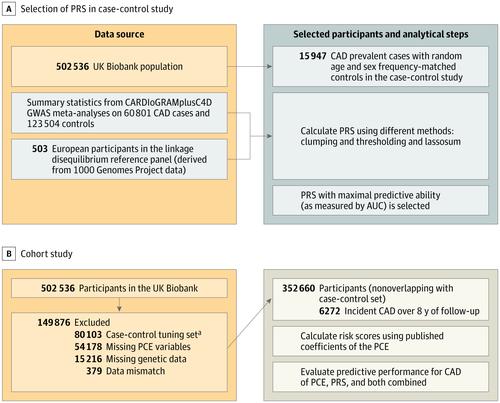Our official English website, www.x-mol.net, welcomes your
feedback! (Note: you will need to create a separate account there.)
Predictive Accuracy of a Polygenic Risk Score–Enhanced Prediction Model vs a Clinical Risk Score for Coronary Artery Disease
JAMA ( IF 63.1 ) Pub Date : 2020-02-18 , DOI: 10.1001/jama.2019.22241 Joshua Elliott 1 , Barbara Bodinier 1 , Tom A Bond 1 , Marc Chadeau-Hyam 1 , Evangelos Evangelou 1, 2 , Karel G M Moons 3 , Abbas Dehghan 1, 4 , David C Muller 1 , Paul Elliott 1, 4, 5 , Ioanna Tzoulaki 1, 2, 4
JAMA ( IF 63.1 ) Pub Date : 2020-02-18 , DOI: 10.1001/jama.2019.22241 Joshua Elliott 1 , Barbara Bodinier 1 , Tom A Bond 1 , Marc Chadeau-Hyam 1 , Evangelos Evangelou 1, 2 , Karel G M Moons 3 , Abbas Dehghan 1, 4 , David C Muller 1 , Paul Elliott 1, 4, 5 , Ioanna Tzoulaki 1, 2, 4
Affiliation

|
Importance
The incremental value of polygenic risk scores in addition to well-established risk prediction models for coronary artery disease (CAD) is uncertain. Objective
To examine whether a polygenic risk score for CAD improves risk prediction beyond pooled cohort equations. Design, Setting, and Participants
Observational study of UK Biobank participants enrolled from 2006 to 2010. A case-control sample of 15 947 prevalent CAD cases and equal number of age and sex frequency-matched controls was used to optimize the predictive performance of a polygenic risk score for CAD based on summary statistics from published genome-wide association studies. A separate cohort of 352 660 individuals (with follow-up to 2017) was used to evaluate the predictive accuracy of the polygenic risk score, pooled cohort equations, and both combined for incident CAD. Exposures
Polygenic risk score for CAD, pooled cohort equations, and both combined. Main Outcomes and Measures
CAD (myocardial infarction and its related sequelae). Discrimination, calibration, and reclassification using a risk threshold of 7.5% were assessed. Results
In the cohort of 352 660 participants (mean age, 55.9 years; 205 297 women [58.2%]) used to evaluate the predictive accuracy of the examined models, there were 6272 incident CAD events over a median of 8 years of follow-up. CAD discrimination for polygenic risk score, pooled cohort equations, and both combined resulted in C statistics of 0.61 (95% CI, 0.60 to 0.62), 0.76 (95% CI, 0.75 to 0.77), and 0.78 (95% CI, 0.77 to 0.79), respectively. The change in C statistic between the latter 2 models was 0.02 (95% CI, 0.01 to 0.03). Calibration of the models showed overestimation of risk by pooled cohort equations, which was corrected after recalibration. Using a risk threshold of 7.5%, addition of the polygenic risk score to pooled cohort equations resulted in a net reclassification improvement of 4.4% (95% CI, 3.5% to 5.3%) for cases and -0.4% (95% CI, -0.5% to -0.4%) for noncases (overall net reclassification improvement, 4.0% [95% CI, 3.1% to 4.9%]). Conclusions and Relevance
The addition of a polygenic risk score for CAD to pooled cohort equations was associated with a statistically significant, yet modest, improvement in the predictive accuracy for incident CAD and improved risk stratification for only a small proportion of individuals. The use of genetic information over the pooled cohort equations model warrants further investigation before clinical implementation.
中文翻译:

冠状动脉疾病多基因风险评分增强预测模型与临床风险评分的预测准确性
重要性 除了完善的冠状动脉疾病 (CAD) 风险预测模型之外,多基因风险评分的增量价值尚不确定。目的 检验 CAD 多基因风险评分是否能改善风险预测,超越汇总队列方程。设计、设置和参与者 对 2006 年至 2010 年注册的英国生物银行参与者进行的观察性研究。使用 15 947 例流行 CAD 病例和同等数量的年龄和性别频率匹配对照的病例对照样本来优化多基因的预测性能CAD 风险评分基于已发表的全基因组关联研究的汇总统计数据。使用由 352 660 名个体组成的单独队列(追踪至 2017 年)来评估多基因风险评分、合并队列方程以及两者组合对 CAD 事件的预测准确性。暴露 CAD 的多基因风险评分、汇总队列方程以及两者的组合。主要结果和措施 CAD(心肌梗塞及其相关后遗症)。使用 7.5% 的风险阈值对区分、校准和重新分类进行了评估。结果 在用于评估所检查模型的预测准确性的 352 660 名参与者(平均年龄 55.9 岁;205 297 名女性 [58.2%])队列中,在平均 8 年的随访期间,发生了 6272 起 CAD 事件。多基因风险评分、合并队列方程以及两者相结合的 CAD 判别结果的 C 统计值为 0.61(95% CI,0.60 至 0.62)、0.76(95% CI,0.75 至 0.77)和 0.78(95% CI,0.77 至 0.77)。 0.79),分别。后 2 个模型之间 C 统计量的变化为 0.02(95% CI,0.01 至 0.03)。模型的校准显示,合并队列方程对风险的高估,在重新校准后得到了纠正。 使用 7.5% 的风险阈值,将多基因风险评分添加到合并队列方程中,病例的净重新分类改善为 4.4%(95% CI,3.5% 至 5.3%),病例的净重新分类改善为 -0.4%(95% CI,-对于非病例(总体净重新分类改善,4.0% [95% CI,3.1% 至 4.9%]),为 0.5% 至 -0.4%)。结论和相关性 将 CAD 多基因风险评分添加到合并队列方程中,与 CAD 事件预测准确性的统计显着但适度的改善相关,并且仅改善了一小部分个体的风险分层。在汇集队列方程模型上使用遗传信息值得在临床实施之前进行进一步研究。
更新日期:2020-02-18
中文翻译:

冠状动脉疾病多基因风险评分增强预测模型与临床风险评分的预测准确性
重要性 除了完善的冠状动脉疾病 (CAD) 风险预测模型之外,多基因风险评分的增量价值尚不确定。目的 检验 CAD 多基因风险评分是否能改善风险预测,超越汇总队列方程。设计、设置和参与者 对 2006 年至 2010 年注册的英国生物银行参与者进行的观察性研究。使用 15 947 例流行 CAD 病例和同等数量的年龄和性别频率匹配对照的病例对照样本来优化多基因的预测性能CAD 风险评分基于已发表的全基因组关联研究的汇总统计数据。使用由 352 660 名个体组成的单独队列(追踪至 2017 年)来评估多基因风险评分、合并队列方程以及两者组合对 CAD 事件的预测准确性。暴露 CAD 的多基因风险评分、汇总队列方程以及两者的组合。主要结果和措施 CAD(心肌梗塞及其相关后遗症)。使用 7.5% 的风险阈值对区分、校准和重新分类进行了评估。结果 在用于评估所检查模型的预测准确性的 352 660 名参与者(平均年龄 55.9 岁;205 297 名女性 [58.2%])队列中,在平均 8 年的随访期间,发生了 6272 起 CAD 事件。多基因风险评分、合并队列方程以及两者相结合的 CAD 判别结果的 C 统计值为 0.61(95% CI,0.60 至 0.62)、0.76(95% CI,0.75 至 0.77)和 0.78(95% CI,0.77 至 0.77)。 0.79),分别。后 2 个模型之间 C 统计量的变化为 0.02(95% CI,0.01 至 0.03)。模型的校准显示,合并队列方程对风险的高估,在重新校准后得到了纠正。 使用 7.5% 的风险阈值,将多基因风险评分添加到合并队列方程中,病例的净重新分类改善为 4.4%(95% CI,3.5% 至 5.3%),病例的净重新分类改善为 -0.4%(95% CI,-对于非病例(总体净重新分类改善,4.0% [95% CI,3.1% 至 4.9%]),为 0.5% 至 -0.4%)。结论和相关性 将 CAD 多基因风险评分添加到合并队列方程中,与 CAD 事件预测准确性的统计显着但适度的改善相关,并且仅改善了一小部分个体的风险分层。在汇集队列方程模型上使用遗传信息值得在临床实施之前进行进一步研究。











































 京公网安备 11010802027423号
京公网安备 11010802027423号